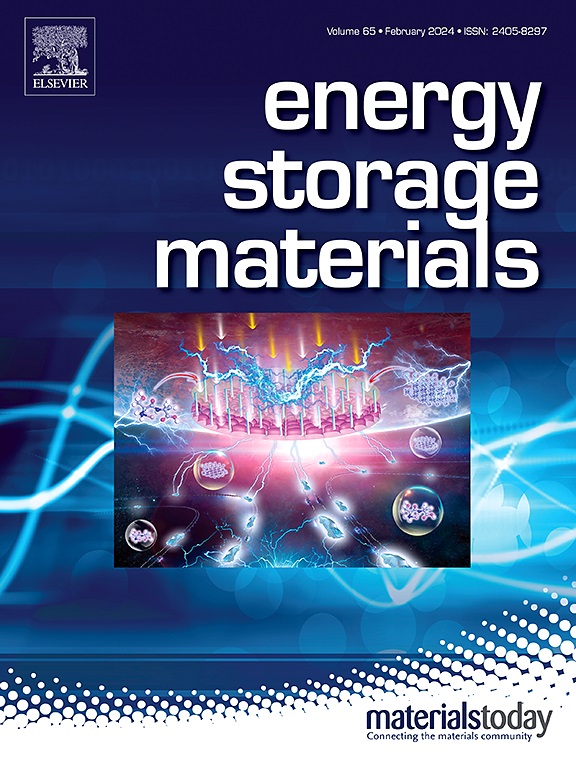高速率和低温氨离子电池/超级电容器的动力学见解
IF 20.2
1区 材料科学
Q1 CHEMISTRY, PHYSICAL
引用次数: 0
摘要
铵离子电池/超级电容器(AIBs/AISCs)具有无金属枝晶、无腐蚀、低成本等优点,近年来受到越来越多的关注。NH4+具有灵活的四面体构型,依靠氢键进行电荷的迁移和转移,这与刚性的球形金属离子和金属配位相互作用完全不同;因此,aib / aisc在速率性能上更胜一筹。基于这些优势,aib /AISCs在需要高功率、安全性和成本效益的领域(如新能源汽车、集成储能系统和高空飞行器)显示出巨大的潜力。尽管如此,速率能力和低温性能需要改进,才能在应用中产生重大影响。鉴于这种独特的动力学行为,对AIBs/AISCs的最新进展进行系统回顾是必要的。本文根据材料分类重点介绍了阴极、阳极和电解质的研究进展。综述了它们的动力学行为、NH4+转运机制、已报道的增强动力学和低温耐受性的策略以及尚未解决的问题。本文还介绍了一些有利于提高倍率性能的新型器件结构设计,如双离子电池、氨-氧电池、氨-金属电池等。通过这篇综述,可以清楚地看到每种主要材料的具体特征,以及设备层面的创新设计,因此研究人员可以进行有针对性的研究。我们希望能够促进高速率低温AIBs/ aids的研究,并最终促进其实际应用。本文章由计算机程序翻译,如有差异,请以英文原文为准。


Kinetic insights for high-rate and low-temperature ammonium-ion batteries/supercapacitors
Ammonium ion batteries/supercapacitors (AIBs/AISCs) have the metal dendrite-free, corrosion-free, and low-cost advantages, attracting growing attention recently. Besides, NH4+has a flexible tetrahedral configuration and relies on hydrogen bonds to migrate and transfer charges, which are totally different from the rigid spherical metal ions and metallic coordination interactions; thus, AIBs/AISCs are superior in rate performance. Based on these advantages, AIBs/AISCs show great potential in the fields that require high power, safety, and cost effectiveness (e.g., new-energy vehicles, integrated energy storage systems, and altitude flight vehicles). Still, rate capabilities and low-temperature performance need to be improved before they can make major effects in applications. Given this unique kinetic behaviour, a systematic review of recent advancements in AIBs/AISCs is essential. This review highlights the progress of cathodes, anodes, and electrolytes according to the material classification. Their kinetic behaviors, NH4+ transport mechanisms, reported strategies to enhance kinetics and low-temperature tolerance, and unsolved issues are all summarized. Some novel device configuration designs beneficial to rate performance are also demonstrated, e.g., dual-ion, ammonium-O2, ammonium-metal cells, etc. Through this review, specific characteristics of every type of major materials are clear to see, as well as innovative designs at the device level, so researchers can conduct targeted investigations. We hope to stimulate the research on high-rate low-temperature AIBs/AISDs, and eventually promote their practical applications.
求助全文
通过发布文献求助,成功后即可免费获取论文全文。
去求助
来源期刊

Energy Storage Materials
Materials Science-General Materials Science
CiteScore
33.00
自引率
5.90%
发文量
652
审稿时长
27 days
期刊介绍:
Energy Storage Materials is a global interdisciplinary journal dedicated to sharing scientific and technological advancements in materials and devices for advanced energy storage and related energy conversion, such as in metal-O2 batteries. The journal features comprehensive research articles, including full papers and short communications, as well as authoritative feature articles and reviews by leading experts in the field.
Energy Storage Materials covers a wide range of topics, including the synthesis, fabrication, structure, properties, performance, and technological applications of energy storage materials. Additionally, the journal explores strategies, policies, and developments in the field of energy storage materials and devices for sustainable energy.
Published papers are selected based on their scientific and technological significance, their ability to provide valuable new knowledge, and their relevance to the international research community.
 求助内容:
求助内容: 应助结果提醒方式:
应助结果提醒方式:


